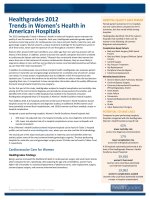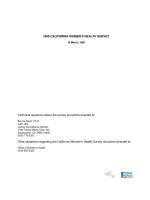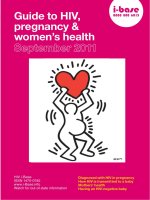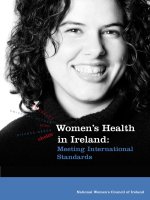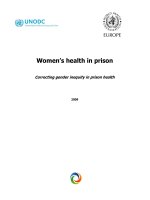Conversation on women’ s health docx
Bạn đang xem bản rút gọn của tài liệu. Xem và tải ngay bản đầy đủ của tài liệu tại đây (323.56 KB, 17 trang )
MAY 28, 2007
Submitted to the Conversation on Health
July 31, 2007
by
THE MEMBERS OF THE WOMEN’S HEALTH COMMUNITY ADVISORY COMMITTEE:
BC Coalition of People with Disabilities
Pacic Association of First Nations Women
Pacic Immigrant Resources Society
Vancouver Women’s Health Collective
Women Against Violence Against Women
conversation on
women
’
s health
BC Coalition
of People with
Disabilities
Pacic
Association of
First Nations
Women
Pacic
Immigrant
Resources
Society
Vancouver
Women’s
Health
Collective
Women Against
Violence
Against Women
table of contents
Executive Summary
page 3
Public Policy Recommendations
page 4
Conversation on Women’s Health
Background Information
Highlights of the 3 Conversations
Highlights of the Questionnaire
page 7
The Determinants of Health
page 12
Statistics & Women’s Wellbeing
page 13
A Snapshot of Program Cuts & Fee Increases in BC
page 14
Organizations Hosting Information Tables
page 16
References
page 17
As the author of this report, the Vancouver Women’s Health Collective would like to thank all
of the women who participated in the Conversation on Women’s Health.
July 2007, Vancouver, BC, Canada.
For further information, please contact: 604-736-4234 or
CONVERSATION ON WOMEN’S HEALTH
executive summary
Over 200 women engaged in a Conversation on Women’s Health at Heritage Hall
in Vancouver, on May 28, 2007. Women around the world mark the International
Day of Action for Women’s Health each year on May 28. This is Vancouver’s fifth
year celebrating the International Day of Action and Canada’s only event.
Our Conversation on Women’s Health is in response to Premier Gordon
Campbell’s September 2006 launch of BC’s Conversation on Health.
The Premier urged “British Columbians to ask tough questions” in order to
“improve public health services today and to protect public health services
for future generations.” We decided to respond to the premier’s challenge by
providing women with an opportunity to come together and share their concerns
about their health and our health care system.
Women were invited to the International Day of Action for Women’s Health event
to participate in one, two or all three Conversations on Women’s Health. The
three women’s health conversations were focused on the following themes:
• Quality Housing and a Living Income
• What Health Services do you Need?
• The Social Determinants of Health: The Issues and Solutions
All women’s comments were recorded and transcribed forming the basis of this
report and the 28 recommendations relating to four broad categories including
housing, income and other financial support, women-centred services, and health
care services. Women also had an opportunity to share their thoughts about their
health and BC’s health care system through a questionnaire. The top 3 health
priorities for the 93 women who completed the questionnaire are housing; a
living income; and violence against women.
A significant conclusion of the Conversation on Women’s Health is that, for
women, health care is not just about hospitals, doctors, and sickness. The 28
recommendations resulting from our Conversation on Women’s Health are
wide-ranging and encompass the determinants of health. Women spoke about
the impact of inadequate housing, poverty, and violence on their health. As well,
women raised concerns about the lack of access to necessary health care services
and the importance of their children’s health.
We urge the provincial government, through its Conversation on Health, to take
action across government ministries to improve the health and wellbeing of British
Columbians. It will be a missed opportunity if the provincial government focuses
solely on recommendations under the jurisdiction of the Ministry of Health. Our
28 recommendations, if the provincial government chooses to act upon them, will
lead to improved outcomes for women’s health and wellbeing in British Columbia.
page 3
“I don’t know how
we can start talking
about our health if
we don’t have safe,
affordable, adequate
housing and we
don’t have enough
money to buy food,
to buy clothes for our
children, to have a
decent life here”.
~ participant,
Conversation on
Women’s Health
The provincial
government should
“look closely at the
crossover jurisdictions
of different ministries
and find ways that
these ministries would
be able to share
responsibilities for
women’s health”.
~ questionnaire respondent,
Conversation on
Women’s Health
CONVERSATION ON WOMEN’S HEALTH
public policy recommendations
These 28 recommendations for provincial government action are a result of
the comments made by the women who participated in the Conversation on
Women’s Health. The 28 recommendations fall into four broad categories and
illustrate women’s belief that their health is about their own, their family’s and
their community’s total health and wellbeing.
We call on the provincial government to act on these 28 recommendations in
order to improve the quality of women’s health in British Columbia:
Invest in Housing for Women
Recommendation #1:
The provincial government needs to build more supportive housing and
affordable housing for women.
Recommendation #2:
The provincial government should provide supportive housing for women living
in the Downtown Eastside, as well as for women with specific needs such as
mental illness, disability, and addictions.
Recommendation #3:
The provincial government should designate some of the hotels it recently
purchased as women-only housing.
Recommendation #4:
The provincial government should provide community housing and
interpretation services for women including elderly women in Chinatown.
Recommendation #5:
The provincial government needs to ensure that there is a women-only emergency
shelter in the Downtown Eastside.
Invest in more Income and Other Financial Support for Women
Recommendation #6:
The provincial government should increase the minimum wage.
Recommendation #7:
The provincial government needs to increase Income Assistance rates.
Recommendation #8:
The provincial government needs to restructure Pharmacare and expand coverage
so that all women can get the medications they need without cost.
page 4
“…don’t take for
granted that the
system has to be
the way it is. It
doesn’t have to be
that way…”.
~ participant,
Conversation on
Women’s Health
Recommendation #9:
The provincial government needs to restructure Disability Benefits in order to
better meet women’s needs.
Recommendation #10:
The provincial government should restore services cut under the Medical Services
Plan including physiotherapy, chiropractic care, podiatry, eye care, massage
therapy, and naturopathic and homeopathic care.
Recommendation #11:
The provincial government should extend MSP to cover dental care.
Invest in Women-Centred Services
Recommendation #12:
The provincial government should fund women-only alcohol and drug addiction
treatment services.
Recommendation #13:
The provincial government should increase funding for mental health services for
women.
Recommendation #14:
The provincial government should increase funding for women’s counselling
services including counselling for drug and alcohol addictions and post-partum
depression.
Recommendation #15:
The provincial government should provide increased funding for programs that
support immigrant women.
Recommendation #16:
The provincial government should support a universal and publicly funded
childcare system.
Recommendation #17:
The provincial government should increase supports for all mothers including
single mothers.
Recommendation #18:
The provincial government should provide businesses with incentives so that
businesses will promote family friendly policies that support women.
Recommendation #19:
The provincial government needs to restore funding to women’s centres.
Recommendation #20:
The provincial government needs to reestablish the Ministry of Women’s Equality.
page 5
“So, we need
to find alternative
solutions that remain
positive and within
the public system
that is universal
and equitable”
~ participant,
Conversation on
Women’s Health
Invest in Health Care for Women
Recommendation #21:
The provincial government needs to provide funding and incentives to ensure
more women practicing family medicine graduate from medical school and that
these doctors provide the full range of care for women patients.
Recommendation #22:
The provincial government needs to provide funding and incentives to ensure
that nurse practitioners are fully integrated into front line primary care in BC;
women need greater access to nurse practitioners as primary care givers.
Recommendation #23:
The provincial government needs to provide incentives to ensure that health care
practitioners work in collaborative teams and that these health practitioner teams
are informed about women’s health care.
Recommendation #24:
The provincial government needs to establish more community clinics.
Recommendation #25:
The provincial government needs to increase funding for home care and support
to enable women with disabilities and seniors to live in their homes.
Recommendation #26:
The provincial government should ensure that hospitals provide staff training in
universal precautions to stop the spread of infectious diseases.
Recommendation #27:
The provincial government should increase funding for health care research that
is centred around women’s health.
Recommendation #28:
The provincial government should find solutions for the health care challenges
that we face within the public health care system.
page 6
“We all care about
healthcare. We
can strengthen the
Canada Health Act.
We can improve
things and protect
them for the future.
But to succeed, we
will have to be open to
one another’s ideas.
We will have to learn
from one another. We
will have to listen to
one another. We will
have to encourage
different voices and
new thoughts and
different ideas. It is
time for a constructive
conversation where
all British Columbians
talk with one another,
listen to one another,
and learn from
one another.”
~ Premier Gordon Campbell,
Speech to launch the
Conversation on Health,
September 28, 2006.
CONVERSATION ON WOMEN’S HEALTH
background information
Over 200 women engaged in a Conversation on Women’s Health at Heritage Hall
in Vancouver, on May 28, 2007. Women around the world mark the International
Day of Action for Women’s Health each year on May 28. This is Vancouver’s fifth
year in celebrating the International Day of Action and Canada’s only event.
In his September 2006 speech to launch the Conversation on Health, Premier
Gordon Campbell urged British Columbians to “ask tough questions”. We
responded to the premier’s challenge by providing women with an opportunity
to come together and share their concerns about their health and our health care
system at a Conversation on Women’s Health.
The Vancouver Women’s Health Collective founded the Women’s Health
Community Advisory Committee in 2006, inviting four community groups to
join in organizing the Conversation on Women’s Health. The WHCAC includes:
• BC Coalition of People with Disabilities
• Pacific Association of First Nations Women
• Pacific Immigrant Resources Society
• Vancouver Women’s Health Collective
• Women Against Violence Against Women
Women were invited to Heritage Hall in Vancouver on May 28 to participate
in one, two or all three Conversations on Women’s Health. Over 200 women
attended the event and almost half of them raised their concerns or made
suggestions about how to improve women’s health care in BC. In addition, 30
organizations hosted information tables at the Conversation on Women’s Health.
(See page 16 for the complete list.)
The three Conversations on Women’s Health were entitled:
#1 Quality Housing and a Living Income
• 29 of the 69 participants shared their thoughts on this topic.
#2 What Health Services do you Need?
• 20 of the 65 participants spoke about their needs.
#3 The Social Determinants of Health: The Issues and Solutions
• 38 of the 55 participants shared their thoughts with us.
A representative of the Pacific Association of First Nations Women facilitated the
first conversation, Women Against Violence Against Women the second, and the
Vancouver Women’s Health Collective provided a facilitator for the afternoon
conversation. Facilitators briefly introduced the themes of the conversation
then opened the floor for participants to share their views. All of the women’s
comments were recorded and then later transcribed.
As well, 93 women completed questionnaires asking them to rank their health
priorities. The top 3 priorities for women are housing, living income, and
page 7
violence against women. (Please see page 10 for questionnaire results.)
Women also had an opportunity to express their views about women’s health
by sharing their thoughts on flip charts situated around the room. One woman
shared the following: “Being born and raised in a relatively privileged (not
sheltered) family, I realize how lucky I have been in my life. My parents have
always had to work incredibly hard to support our family and they still do. As
I enter the workforce, I recognize more the challenges they faced everyday and
the challenges the women present today have had to face to keep themselves
and their families healthy. I am so grateful and proud to be in the same room as
these women and to be associated with today’s event. In the face of seemingly
overwhelming odds stacked against us, it is our courage and determination to
fight for what is right that will one day create a better future for our families.”
highlights of the 3 conversations
The Highlights of Conversation #1
Quality Housing & A Living Income
Themes that were raised by participants…
• Women want to work one job at a fair wage
• Wage cuts hurt women and their families
• Housing is a fundamental human right
• The provincial government needs to build more supportive housing and
affordable housing, as well as housing for women with specific needs
i.e. mental illness, disabilities, etc.
• Re-opening Riverview Hospital is not the answer to the housing needs of most
homeless women with a mental illness
• Waitlists for BC housing are too long
• Shelter beds are not the answer to the housing shortage facing women
• The provincial government needs to change direction
• Privatization of health care hurts women
• Government cuts to services hurt women and their children
• Women need greater access to medication and medical services
• Women feel isolated
The Highlights of Conversation #2
What Health Services do you Need?
Themes that were raised by participants…
• Women want to see a female doctor and need greater access to female doctors
• We need medical procedures i.e. pap tests and mammograms that are less
intrusive
page 8
• Emergency room wait times are too long
• Care at our hospitals needs to be more compassionate
• Women need access to community-based alcohol and drug addiction
treatment services including treatment for crystal meth
• We need greater awareness around post-partum depression and more access
to services to assist women
• Homeopathy needs to be covered under the Medical Services Plan
• Prescription drugs need to be free
• Women need access to unbiased information about pharmaceutical drugs
• We need a women-only emergency shelter in the Downtown Eastside
• Income Assistance rates need to be increased
• Drug use is a health issue
• The government needs to fulfill its Olympic promise to build housing
• Service providers need to hire more first nations women
• Walk-in clinics do not provide good care/continuity of care
• Disability Benefits need to better meet women’s needs
• Doctors need to be better educated at medical schools regarding violence
against women and its impact on women’s health, the importance of filling
out forms for government benefits (disability), and to be more compassionate
and caring health providers
The Highlights of Conversation #3
The Social Determinants of Health: The Issues and Solutions
Themes that were raised by participants…
• Women’s experiences with racism, oppression, poverty and lack of
government support impedes women’s equality and negatively impacts
women’s health
• Women recognize the importance of women working together and the
importance of the women’s movement
• Women’s voices are important
• Funding for women’s centres must be restored
• The Ministry of Women’s equality needs to be reestablished
• Young women’s needs and their vulnerability to exploitation are often
overlooked
• Society needs a better understanding of healthy body image for women
highlights of the questionnaire
• 93 questionnaires were completed by women
• The age range of questionnaire respondents was from 19 to 83 years of age
page 9
• The largest grouping of respondents were in their 40s (22 women) while
women in their 30s came a close second with 20 women completing the
questionnaire
• Women identified Spanish, Vietnamese, Mandarin, Cantonese, French, Italian
and English as languages they spoke
• Women identified themselves as First Nations, Asian, and Caucasian
page 10
Health Most Medium Total %
Housing
85 5 90 97
Living income (welfare rates,
pensions, minimum wage)
80 8 88 95
Violence against women
81 6 87 94
Food and diet
68 16 84 90
Children’s health care
76 6 82 88
Drug and alcohol addiction
67 14 81 87
Medical Services Plan (MSP)
61 20 81 87
Finding a family doctor
70 10 80 86
Emergency room care
68 10 78 84
Counselling
60 18 78 84
Reproductive health service
58 20 78 84
Cost of prescription drugs
53 25 78 84
Dental care
67 10 77 83
Prevention and health promotion
63 13 76 82
Access to medical equipment
55 18 73 78
Complementary therapies (i.e.
naturopath, chiropractor, massage)
46 26 72 77
Transportation
46 25 71 76
Health information in your first
language
59 11 70 75
Interpretation services
50 20 70 75
Traditional or spiritual health
44 26 70 75
Waiting lists
58 10 68 73
In response to the following question: What should the provincial government do
to improve women’s health care in BC? Women wrote the following:
“Recognize the need for women-specific health care in safe environments.”
“Open a women’s only clinic with an all female staff.”
“Address women’s disproportionate lower income, pension, wages.”
“We need a government that is more balanced between economic growth
and social programs and that empowers the health and wellbeing of all people.”
“Provide funding and support allowing women’s services and advocacy groups to
remain robust.”
“Listen to them and their needs instead of assuming they
know what is best for women.”
“Create more avenues for participation in health governance by women, elders,
youth, the poor.”
“Poverty is the biggest predictor of poor health.”
page 11
CONVERSATION ON WOMEN’S HEALTH
the determinants of health
The 28 recommendations arising from the Conversation on Women’s Health fall
into four broad categories including housing, income and other financial support,
women-centred services, and health care services. These 28 recommendations
illustrate women’s understanding of health – it is about their own, their
family’s and their community’s total health and wellbeing. As the World Health
Organization declared in 1948, health is “a state of complete physical, mental and
social well being and not merely the absence of disease or infirmity.”
Further to this, according to the federal government’s Public Health Agency
of Canada’s web site: “At every stage in life, health is determined by complex
interactions between social and economic factors, the physical environment and
individual behaviour. These factors are referred to as “determinants of health.”
They do not exist in isolation from each other. It is the combined influence of the
determinants of health that determines health status.”
In 1998, Health Canada developed a list of the factors that lead to healthy people
and communities. Now the Public Health Agency of Canada identifies the
following as the key determinants of health:
1. Income and social status
2. Social support networks
3. Education and literacy
4. Employment/working conditions
5. Social environments
6. Physical environments
7. Personal health practices and coping skills
8. Healthy child development
9. Biology and genetic endowment
10. Health services
11. Gender
12. Culture
We urge the provincial government, through its Conversation on Health, to
take action across government ministries to improve the health and wellbeing
of British Columbians. It will be a missed opportunity if the provincial
government focuses solely on recommendations under the jurisdiction of the
Ministry of Health.
page 12
CONVERSATION ON WOMEN’S HEALTH
statistics and women
’
s wellbeing
• 1.9 million women lived in a low-income situation in 2003
• 38% of lone-parent mothers, 19% of all senior women, and 25% of visible
minority senior women lived in a low-income situation in 2003
• 36% of all Aboriginal females were living in a low-income situation in 2000
• 35% of women who had recently immigrated to Canada (between 1991-2000)
were living in a low-income household in 2000
• 81.3% of the 1.3 million lone-parent families in Canada in 2001 were headed
by women
• Almost 2 million women, 13% of the total 2001 female population, had a
disability
• 54% of disabled Canadians are women and their average annual income is
$17,200, almost $10,000 less than a man with a disability who on average
makes $26,900
• Women earn 71 cents for every dollar a man earns
• In 2003, men had an average annual pre-tax income of $39,300 while women’s
average annual income was $24,000 – a $15,000 difference
• In 2000, the median income of an Aboriginal woman was $12,300
• A senior woman’s average annual income is $20,000, $10,000 less than a senior
man’s income
• 70% of people who work part-time are women and 26% of them want
full-time work
• Women account for 55% of all multiple job holders in 2004, up from 42%
in 1987
• In 2004, 653,000 women aged 15 and over experienced spousal violence in the
past five years
• Relatives or acquaintances made up 70% of the assailants in violent incidents
against women, in 2004
Source: Statistics Canada, Women in Canada, A gender-based statistical report, 2005
page 13
CONVERSATION ON WOMEN’S HEALTH
a snapshot of program cuts & fee increases in BC
Housing
• In March 2002, the provincial government cancelled the Homes BC program
which had successfully built thousands of social housing units.
• The provincial government shifted its housing efforts in 2002 to building
independent living for frail seniors in order to take some of the pressure
off the health budget.
• The provincial government announced in October 2001, under then Housing
Minister George Abbott, that the private and non-profit sectors had to solve
the affordable housing crisis in BC.
Income and Other Financial Support
• The minimum wage, at $8 per hour, has not been adjusted since 2001.
• In 2002, the provincial government introduced a $6 “training wage” for new
workers.
• In 2002, the provincial government cut Income Assistance rates by between
$47 and $98 per month depending on the Income Assistance category an
individual fell into. The Family Maintenance Exemption was eliminated
for single parents and the Earnings Exemption was eliminated. The shelter
allowance for families of 3 or more was reduced by $50-75 per month.
• In recognition of the hardship caused by past cuts to Income Assistance rates,
the provincial government increased Income Assistance by $50 per month and
increased the shelter portion of Income Assistance by $50 per month, effective
April 1, 2007.
• Eligibility for Income Assistance also changed in 2002 including the
introduction of a 3-week waiting period.
• Effective 2002, single parents (typically mothers) were considered employable
after their child reached 3 years of age, previously it was when a child was 7.
• People on Income Assistance have had access to physiotherapy, chiropractic
care, massage therapy, eye care, podiatry, and visits to a naturopath severely
reduced to a total of 10 visits a year - with a possible additional 12 visits for
acute flare ups, rather than for chronic conditions - for all of these health
services combined.
• Prior to 2002, individuals on Income Assistance could access 12 visits for each
health service, per year.
page 14
• In 2002, the provincial government also made changes to Disability Benefits
including eliminating the category of Disability I and designating these
individuals as “persons with persistent multiple barriers to employment”
under Income Assistance. These individuals, if they qualified for Income
Assistance, no longer had extra costs associated with their disability
recognized. Individuals who were categorized as Disability II had to re-apply
and were forced to complete a 23-page report to qualify under the new
Disability Assistance program.
• The provincial government cut funding for legal aid by almost 39% in 2002
and eliminated poverty law and family law assistance.
• Over 10,000 unionized health care workers, the majority women, have lost
their jobs since 2002.
Women-Centred Services
• In 2001, the provincial government abolished the population health advisory
committees which provided the health boards with community-based input
into the health of women, Aboriginal people, lesbians, and seniors.
• The provincial government cut 100% of funding for BC’s 37 women’s centres
on April 1, 2004.
• The provincial government dismantled the Ministry of Women’s Equality
when it formed government in 2001.
Health Care Services
• Medical Service Plan (MSP) premiums increased 50% on May 1, 2002.
• In 2002 the Medical Services Plan ended coverage for eye examinations,
physiotherapy, chiropractic care, massage therapy, podiatry, and visits to a
naturopath.
• A family with an income of $37,000 or more pays $1,296 a year for MSP
premiums, a single woman making $28,000 or more a year, pays $648 for MSP.
• In 2003, the provincial government introduced changes to Pharmacare that
resulted in a $90 million cut in the Pharmacare budget offloading these costs
on to individual British Columbians.
• The 2003 changes to Pharmacare eliminated a separate plan for seniors and
eliminated lower deductibles for seniors.
• Between 2000/01 and 2004/05, the number of people receiving home support
in BC dropped by 24%, at same time the number of seniors in BC increased.
page 15
CONVERSATION ON WOMEN’S HEALTH
organizations hosting information tables
In addition to participating at the May 28th Conversation on Women’s Health, the
following community organizations hosted an information table at the event:
1. Abortion Rights Coalition of Canada
2. Blood Pressure Testing
3. BC Health Coalition
4. BC Coalition of People with Disabilities
5. BC Epilepsy Society
6. BC Women’s Hospital
7. Centre for Menstrual Cycle and Ovulation Research (CeMCOR)
8. Domestic Violence Outpatient Clinic
9. Elizabeth Bagshaw Women’s Clinic
10. Everywoman’s Health Centre
11. Grassroots Women
12. Healing Our Spirit
13. Helping Spirit
14. Homeopaths of BC
15. Hospital Employees’ Union
16. Midwives Association of BC
17. National Congress of Black Women
18. OXFAM Canada
19. Pacific Association of First Nations Women
20. Pacific Immigrant Resources Society
21. Pacific Post Partum Support Society
22. Pap Smears and Mammograms
23. Pro-Choice Action Network
24. Sexual Assault Services
25. UBC researcher (chemicals and pregnancy)
26. Vancouver Rape Relief and Women’s Shelter
27. Vancouver Women’s Health Collective
28. Women Against Violence Against Women
29. Women Elders in Action (WE*ACT)
30. WISH (Women’s Information Safe House)
page 16
CONVERSATION ON WOMEN’S HEALTH
references
BC CEDAW Group, BC Moves Backwards on Women’s Equality, January 2003.
BC Conversation on Health, Premier Gordon Campbell’s Speech to Launch of the
Conversation on Health, September 28, 2006.
BC Ministry of Employment and Income Assistance, Increases to Income
Assistance Rates Fact Sheet, February 20, 2007.
Canadian Centre for Policy Alternative, BC Office, and the BC Health Coalition,
From Support to Isolation, June 2006.
Ontario Prevention Clearinghouse, Ontario Chronic Disease Prevention Alliance,
and the Canadian Cancer Society – Ontario Division, Primer to Action: Social
Determinants of Health, 2007.
Public Health Agency of Canada, Population Health Approach Web Site, What
Determines Health? 2007.
Statistics Canada, Women in Canada: A gender-based statistical report, 5th
edition, March 2006.
The Tyee, How Homeless Housing Got Stalled, November 21, 2006.
The Tyee, How We Razed the Affordable House, May 3, 2004.
Vancouver Women’s Health Collective, Women & Health Care in BC: A Gendered
Perspective, May 2006.
Women’s Health Community Advisory Committee, Conversation on Women’s
Health Questionnaires, May 2007.
Women’s Health Community Advisory Committee, Conversation on Women’s
Health Transcripts, May 2007.
page 17

